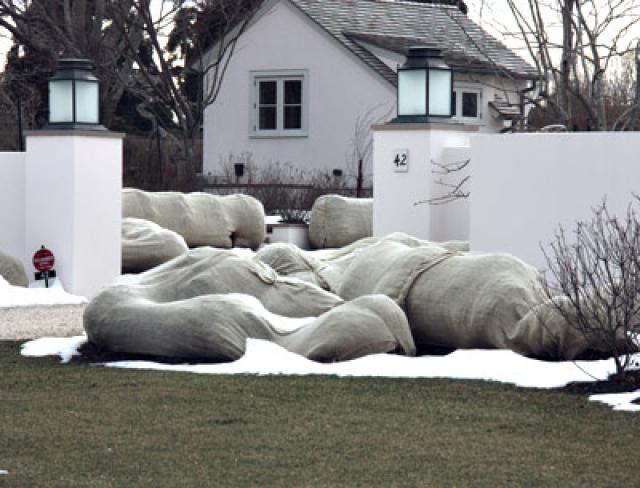Dressed for the Season

Dressed for the season in brown burlap, striking dramatic poses all around town like models on a runway, hundreds of shrubs and trees stand bundled root to crown in their protective winter coats, ready for whatever Jack Frost can throw at them. In recent years the number of these bagged-and-burlapped creations, to be seen on almost any residential street, seems to have exploded, keeping pace, according to local nurseries, not only with the young landscaping around the big new houses but also with the herds of deer that would love to munch on what lies beneath the wrappings. In their slim or chubby contours, especially when glimpsed against a new snowfall, the swaddled shrubs contribute a touch of down-home validity to the South Fork’s holiday tableau, resembling nothing so much as living, breathing, do-not-open-until-spring Christmas presents. Homeowners will often take a do-it-yourself approach to shrub-wrapping, sometimes with comical results. Wikipedia suggests a simple formula: Measure the shrub’s circumference, double it, add six inches, and that’s how much covering you’ll need. (Alas, the Web is tricky on what to do next. Some sites say wrap from the top down, others from the bottom up.) For anything over four feet or so high it’s at least a two-person job, especially on windy days with the burlap flying all over the place and the twine slipping. If it’s not tied tight enough it will droop and slide off; too tight and the bush won’t be able to breathe. Professional wrappers — there’s no such category in the Yellow Pages but all nurseries have a few pros — sew up the twine as they go, producing the astonishingly neat results seen in some of these photos. Nurserymen charge anywhere from $75 to $375 to wrap specimen or newly planted shrubs, depending on size, though here and there you may find one like Charlie Whitmore, who takes a refreshingly laid-back approach to winter protection. “Anything works to repel deer,” he said. “Old T-shirts, a dish cloth — anything that smells like a human, they hate. We only use burlap if we don’t have old T-shirts.” “Sometimes you will see scald on a young tree. Just wrap it with something opaque that keeps the sun from shining on it,” Mr. Whitmore advised. A light film of plastic, like thick Saran Wrap, will work, he said, or, for purists, there’s a paper tree wrap, $15.75 a roll at the Bayberry in Amagansett and elsewhere. “Everyone wraps differently,” Mr. Whitmore said. “Right way, wrong way — I say no way. If they’re not eating it, let it be.”
